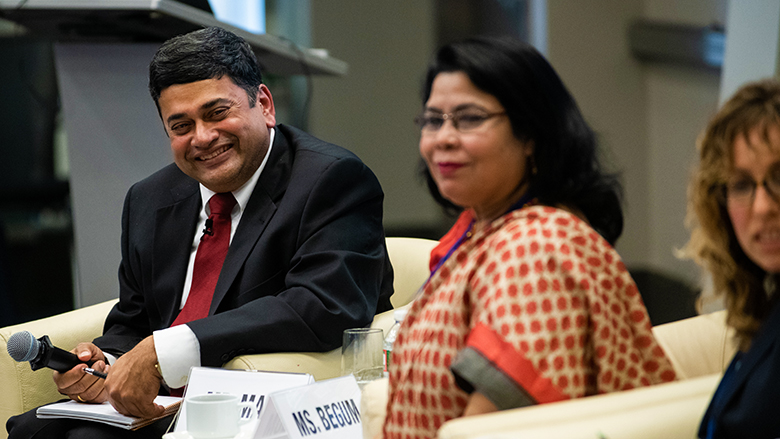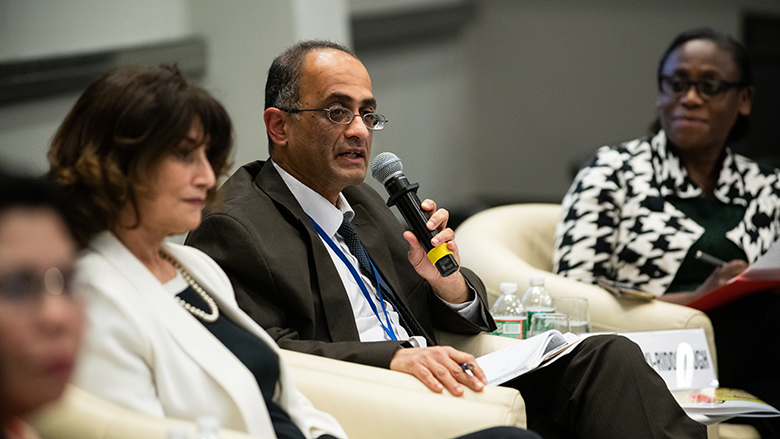Last summer’s monsoon hit South Asia particularly hard and left nearly 1,400 people dead and displaced millions of others.
In the last sixty years, such weather extremes have become more common in the subcontinent and, without urgent action to limit carbon emissions, their impact on communities will likely get worse.
In addition to these extremes, average weather patterns are also changing with each year turning out to be warmer than the previous year and monsoon rainfall patterns are getting more and more erratic.
Eight hundred million South Asians to be exact – or half the region’s population—are at risk to see their standards of living and incomes decline as rising temperatures and more erratic rainfalls will cut down crop yields, make water more scare, and push more people away from their homes to seek safer places.
This worst-case scenario and relevant adaptation strategies underpin the upcoming report South Asia’s Hotspots, whose main findings were presented yesterday at a panel on building climate change resilience in South Asia at the World Bank Spring Meetings.
Its main author, World Bank Lead Economist Muthukumara Mani detailed how specific geographic areas across South Asia or “hotspots” which – until now — were relatively immune to climate change threats could be badly affected by 2050.

World Bank Lead Economist Muthukumara Mani and Ms. Mahmuda Begum, additional Secretary in World Bank Wing at Economic Relations Division at the Bangladesh’s Ministry of Finance. Image: World Bank
Most hotspots, Mani remarked, are located inland, already poor, have fewer roads and are isolated from main economic centers. And with many residents subsisting on farming, higher incidences of droughts or floods combined with extreme heat could further drive down their fragile wellbeing and force more people into poverty.
And while other manifestations of climate change such as sea level rise or natural disasters and their impact on economies have been well documented, less is known of the long-term effects of higher temperatures and unpredictable rainfalls on local communities.
It’s urgent to develop this understanding as most countries in South Asia have already passed their optimal temperature tipping points, beyond which standards of living and consumption are only expected to drop irreversibly.
To build resilience, the report recommends that South Asian countries better prioritize their financial resources where they’re most needed and target the most vulnerable individuals and families.
Mani noted that diversifying jobs beyond agriculture, investing in education and skills, and improving access to electricity can ease the expected decline in living standards caused by long-term climate impacts. Such actions, he argued, must be tailored to address the specific climate impacts and local conditions found in South Asia’s hotspots.
In the end, the cost of inaction—that is, if carbon emissions continue unabated—could be huge as countries with severe hotspots, Mani concluded, would see income in these areas drop by 14.4 percent in Bangladesh, 9.8 percent in India, and 10 percent in Sri Lanka by 2050.
Panel discussion: Building a climate-resilient South Asia
Following the presentation, government, civil society, and academia elaborated on concrete climate actions and adaptation strategies to build a more resilient South Asia.
The panel included Ms. Mahmuda Begum, additional Secretary in World Bank Wing at Economic Relations Division at the Bangladesh’s Ministry of Finance, Ms. Aisha Khan, Executive Director for Civil Society Coalition for Climate Change (CSCCC) and CEO of Mountain and Glacier Organization (MGPO) in Pakistan, Mr. Anand Patwardhan, Professor of Public Policy at the University of Maryland, USA, and Ms. Jaime Madrigano associate policy researcher at the RAND Corporation, USA. Ms. Idah Pswarayi-Riddihough, Country Director for Sri Lanka and the Maldives in the South Asia Region, World Bank Group moderated the discussion.
Noting that Pakistan’s soaring population coupled with shrinking arable lands present a challenge to the country’s environment sustainability and food security, Aisha Khan emphasized that building climate resilience should go hand in hand with better –that is, more open and inclusive—governance. Involving civil society, including women-run organizations, will bring greater accountability to climate change policies that will later impact the entire population. And that sense of co-ownership and shared responsibility, Khan added, is critical to civil society.
Such collaborations are key to building strategic climate resilience and, to be successful in the long term, should extend to partnership between countries. Water presents such an opportunity. “We in South Asia are the third pole…with the densest glaciers outside polar regions in the world,” she said. “Water being a common problem for all of us, we need to do more work together.”

Ms. Aisha Khan, Executive Director for Civil Society Coalition for Climate Change (CSCCC) and CEO of Mountain and Glacier Organization (MGPO) in Pakistan, Mr. Anand Patwardhan, Professor of Public Policy at the University of Maryland, USA, Ms. Idah Pswarayi-Riddihough, Country Director for Sri Lanka and the Maldives in the South Asia Region, World Bank Group. Image: World Bank
When it was his turn to speak, Anand Patwardhan noted that the conversation about climate resilience would have to go beyond risks and be reframed around opportunities to further advance the development agenda. In India, large national programs such as Smart Cities or Swachh Bharat projects are two examples of how climate action can help achieve greater development outcomes. In South Asia, Patwardhan later remarked, a lot of infrastructure still needs to be put into place. There lies an opportunity to invest in natural infrastructure [that benefits both the economy and the environment] and ecosystem adaptation to advance resilience across the region.